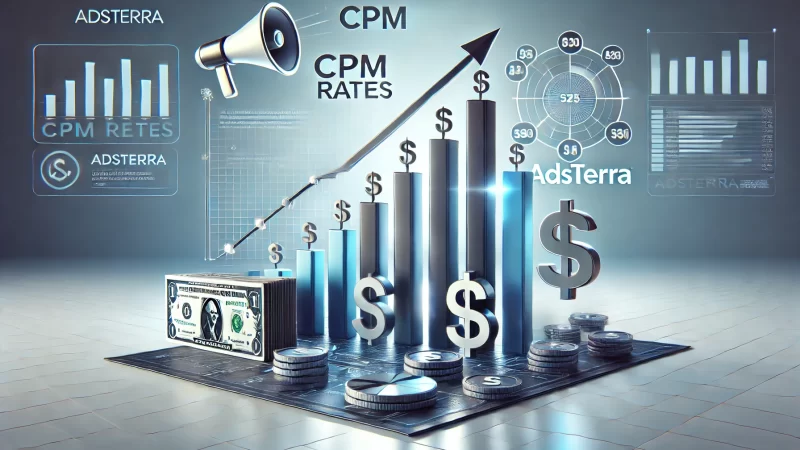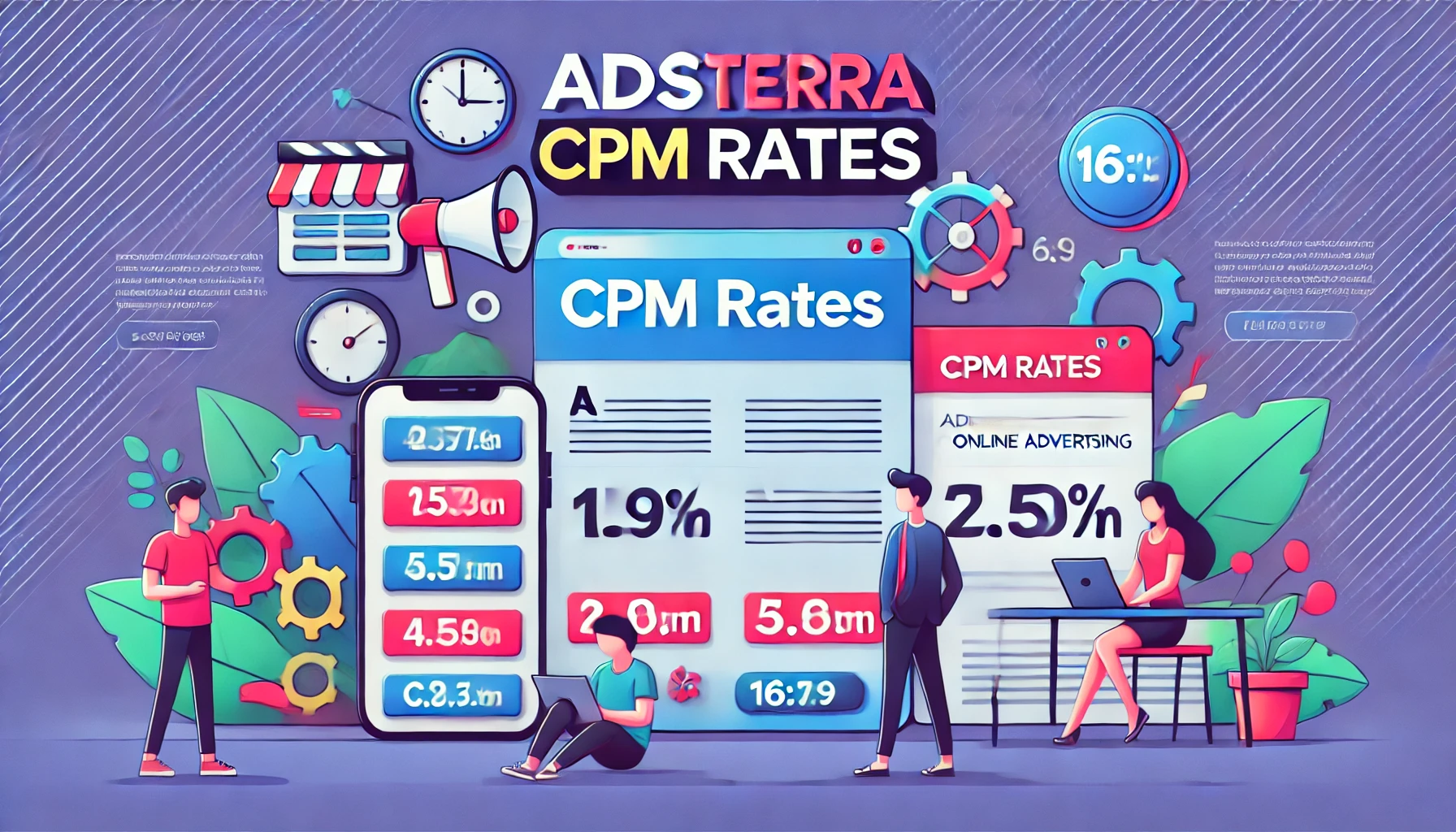Table of Contents
Are you wondering how to maximize your ad revenue with Adsterra? Understanding Adsterra CPM rates can help boost your ad earnings significantly.
In this article, we’ll explore everything you need to know about Adsterra CPM rates, how they work, and the strategies to enhance your ad revenue effectively.
What Are Adsterra CPM Rates?
Adsterra CPM rates are critical metrics that define how much advertisers pay publishers for every 1,000 ad impressions on Adsterra’s network. These rates help publishers understand revenue potential, influencing decisions about ad placements and strategies for revenue optimization.
Understanding CPM In Ad Revenue
CPM, or cost per mille, signifies how much advertisers pay per 1,000 ad impressions. This metric is a staple in the ad revenue ecosystem, setting the standard for assessing ad performance. Publishers often gauge revenue success by CPM rates, as higher CPM rates equate to more earnings per impression. I believe a solid grasp of CPM is essential for anyone serious about boosting their ad revenue.
To maximize CPM, publishers often analyze user behavior and ad interactions, adjusting placements to fit audience preferences. For example, ads placed in high-traffic areas can draw higher engagement, driving up CPM. I suggest experimenting with different ad placements on your site to see which deliver the highest CPM.
Understanding CPM’s value becomes especially relevant for publishers looking to maintain revenue consistency. When your audience engages frequently with ads, advertisers are willing to pay more, benefiting your CPM. High-quality, engaging content encourages interaction, directly impacting your CPM rates.
Maximizing CPM rates also involves understanding what advertisers are willing to invest. CPM rates fluctuate based on advertiser demand, so publishers should regularly analyze their CPM trends to spot opportunities to improve revenue by tweaking content and ad layouts.
How Adsterra Calculates CPM Rates
Adsterra’s CPM rates are calculated based on the number of impressions and the ad’s engagement level with users. The network monitors impression volume, ad type, and viewer interaction to gauge an ad’s overall effectiveness. More interaction from users often results in higher CPM rates.
Adsterra prioritizes ad quality, ensuring that impressions meet advertiser standards. This quality focus makes CPM rates not only a revenue indicator but also a reflection of user engagement on your site. I suggest optimizing for user experience, as it can directly impact your CPM rates.
CPM calculations also consider the advertiser’s bid, meaning demand for specific ad formats or niches may influence rates. A higher bid often translates to higher CPMs, especially in competitive niches. Publishers should monitor ad trends within their niche for insights on maximizing CPM.
The frequency of impressions can drive up Adsterra CPM rates, especially when combined with engaging content. Consistently attracting impressions through fresh content helps maintain a steady CPM, benefiting your long-term ad revenue strategy.
Factors Influencing Adsterra CPM Rates
Various factors impact Adsterra’s CPM rates, with audience demographics playing a significant role. Viewers from countries with high ad demand, like the United States, typically yield higher CPM rates. I recommend targeting high-traffic locations to optimize CPM.
Ad format also shapes CPM potential. For example, popunder ads and video ads often yield higher CPMs compared to banner ads due to their immersive nature. I advise experimenting with different ad formats to find those that maximize revenue for your site.
Time of year and seasonal trends can also influence CPM rates, as advertiser budgets fluctuate throughout the year. I suggest keeping track of seasonal ad demand to optimize CPM rates when certain ads see a surge in value, boosting your earnings during peak periods.
Site quality, from load speed to mobile-friendliness, can significantly impact CPM rates on Adsterra. Fast, well-designed sites tend to perform better with users and advertisers, leading to higher CPMs. Improving site quality could enhance your CPM and overall ad performance.
Why Adsterra CPM Rates Matter For Publishers

Adsterra CPM rates are essential for publishers aiming to maximize ad revenue, as these rates directly affect potential earnings per 1,000 impressions. High CPM rates empower publishers to increase revenue without relying solely on traffic growth, making effective ad management crucial.
Impact Of CPM Rates On Total Ad Revenue
CPM rates significantly impact your total ad revenue. Higher CPM rates mean more revenue from the same traffic volume, allowing publishers to maximize earnings. I suggest focusing on CPM optimization, as it directly improves your site’s revenue potential.
Adsterra’s CPM rates allow publishers to assess and adapt their ad strategies based on performance. With a strong CPM, you can focus on enhancing ad placements rather than increasing site traffic, balancing revenue growth without overly altering content strategies.
Publishers often track CPM trends to determine which ad formats are performing best. I recommend evaluating CPM regularly to keep ad revenue optimized. This approach helps ensure you’re benefiting from high-yield ads on your platform.
Understanding CPM’s role in total revenue also helps publishers make informed decisions about ad formats and placement. By selecting high-CPM ads, you can enhance earnings with minimal impact on site design, helping maintain user experience while boosting income.
Benefits Of Adsterra’s High CPM Rates
High CPM rates on Adsterra provide publishers with revenue stability, even with modest traffic numbers. These rates allow you to earn competitively, as high CPM ensures each impression’s value is maximized. I suggest using Adsterra’s high-CPM formats for better earnings.
Publishers can rely on Adsterra’s competitive CPM to improve revenue without constantly expanding their audience. Adsterra’s high rates offer a solid return on impressions, giving you the flexibility to prioritize quality traffic over quantity.
Adsterra’s high CPM rates often stem from partnerships with premium advertisers, which raises the ad value for publishers. This alignment helps ensure that your content and ad experience meet the standards needed to sustain high CPMs.
Using Adsterra’s CPM benefits, publishers can focus on creating content without worrying about compromising on revenue. This stable income potential means more resources for content quality, enhancing your site’s value and appeal to advertisers.
Comparing Adsterra CPM With Other Networks
Adsterra CPM rates often compete well with other networks, attracting publishers seeking premium ad revenue. When comparing networks, Adsterra’s CPM rates provide solid income potential, giving publishers a competitive edge. I believe this makes Adsterra an excellent option for revenue optimization.
Publishers looking to diversify ad income often compare networks for the best CPM returns. Adsterra’s strong CPM rates make it a favorable choice, particularly for those prioritizing consistent ad earnings and premium ad formats.
Adsterra’s network often emphasizes high-CPM ad types like popunders and video ads, allowing publishers to choose formats with strong revenue potential. I recommend comparing these rates to ensure you’re maximizing ad revenue potential effectively.
When evaluating networks, consider Adsterra’s comprehensive support and diverse ad options. Adsterra’s high CPM rates and ad variety give publishers flexibility, allowing them to optimize revenue in line with their audience and content needs.
Types Of Adsterra Ad Formats And Their CPM Potential
Adsterra offers multiple ad formats with varying CPM potentials, each designed to help publishers maximize earnings based on their site’s audience and content style. Choosing the right ad format can significantly enhance your revenue on Adsterra.
Popunder Ads: Highest CPM Potential
Popunder ads on Adsterra are highly effective at grabbing user attention without disrupting content flow. These ads appear behind the main browser window, allowing users to engage with them once they close or minimize other tabs. I recommend popunder ads for sites looking to boost revenue without overwhelming their visitors.
Popunder ads perform exceptionally well in generating high CPM due to their unique placement. Many advertisers favor this format, as it guarantees exposure without intrusive interruptions. With strategic placement, popunders can lead to higher engagement and impressive revenue gains.
This ad format suits publishers targeting high-engagement users who spend considerable time on their sites. Popunder ads capitalize on these longer sessions, encouraging users to notice and interact with the ads naturally, boosting overall ad performance.
For maximizing CPM, popunders can be placed strategically, particularly if your audience responds well to full-page or interactive ad experiences. I suggest analyzing your audience’s behavior to see if this format fits their browsing style.
Native Ads: Enhancing User Engagement
Native ads on Adsterra blend seamlessly with site content, making them less intrusive. This ad format is known for driving high engagement, as it aligns with the look and feel of the page. I believe native ads are perfect for publishers prioritizing user experience.
Native ads perform well on content-driven sites, as they offer valuable information while promoting brands subtly. These ads appear as recommended content, which feels natural for users, often resulting in higher click-through rates and engagement levels.
Adsterra’s native ads are effective in generating revenue without compromising site design. These ads are particularly beneficial for audiences who appreciate curated recommendations within their content journey, boosting trust and interaction with the ads.
Optimizing native ads involves carefully integrating them with your content to ensure they enhance rather than disrupt. Native ads, when well-positioned, can provide high CPM without sacrificing user satisfaction, which I suggest monitoring closely.
Display Banners: Maximizing CPM Across Platforms
Display banners are classic yet versatile ads, appearing across different sections of a webpage. On Adsterra, these banners offer a reliable revenue source with moderate to high CPM, especially for publishers with visually engaging sites. I suggest trying different banner placements to discover what suits your audience.
Banner ads can be customized to fit your page design, allowing flexibility in choosing sizes and placements. This adaptability helps in balancing ad presence across your content without overloading the page, providing a steady CPM rate.
Adsterra’s display banners are effective for sites with diverse audiences, as these ads are easily noticed without being intrusive. For instance, placing banners at the top or within articles can capture user attention seamlessly, enhancing CPM results.
Testing different banner sizes and placements on high-traffic pages can maximize engagement. Since banners are a familiar ad type, users are more likely to engage with them on sites they trust, boosting CPM for reliable revenue flow.
Video Ads: High CPM For Engaging Content
Video ads on Adsterra offer some of the highest CPM rates, thanks to their engaging format. These ads work well for content-driven sites, where users are likely to engage with multimedia. I advise testing video ads if you have a visual-centric audience.
Video ads encourage users to spend more time interacting, making them ideal for CPM maximization. Their engaging nature captures attention, resulting in higher retention rates and ad interaction, essential for publishers looking to elevate revenue.
These ads perform especially well on sites with tutorials, guides, or content that naturally incorporates video. I recommend evaluating your site’s content type to determine if video ads would enhance or interrupt the user experience.
Ad placement is critical with video ads to avoid user frustration. By integrating video ads strategically, you can drive high CPM without sacrificing usability, creating a balance that works well for CPM enhancement.
Social Bar Ads: Boosting CPM With Interactive Ads
Social bar ads are interactive and highly engaging, displaying messages similar to social media notifications. These unique ads capture attention quickly and can enhance user interaction, making them valuable for boosting CPM. I suggest using social bar ads for a modern, engaging ad style.
Social bar ads work exceptionally well for sites targeting younger audiences or those familiar with interactive, mobile-like interfaces. Users are drawn to these ads as they mimic notifications, leading to increased engagement and CPM.
These ads suit high-traffic sites, as social bar ads leverage large audiences effectively. For instance, interactive content can resonate with users, driving high engagement and helping publishers achieve better revenue results.
Adsterra’s social bar ads offer a fresh way to engage users without overwhelming content. This ad format provides a solid CPM, making it a versatile option for publishers looking to enhance engagement without intrusive placements.
Proven Ways To Increase Ad Revenue With Adsterra

Boosting ad revenue with Adsterra involves effective strategies in ad placement, format selection, and audience targeting. By understanding how to optimize these elements, publishers can consistently improve their CPM and overall earnings on the platform.
Optimizing Ad Placement For Maximum CPM
Ad placement plays a crucial role in maximizing CPM. Strategic ad positioning captures user attention and increases interaction rates, leading to higher CPM. I suggest experimenting with placements, observing which areas of your site generate the highest engagement.
Ad placement impacts visibility, and certain sections like above-the-fold areas tend to perform better. I recommend placing ads where users naturally focus, such as near headers or within high-traffic sections, as this boosts the likelihood of interaction.
Testing various placements is essential to discover optimal positions without overwhelming users. Balancing ad placement with content flow maintains a positive user experience, ensuring ad revenue benefits without affecting site usability.
Monitoring user engagement in different placements allows you to refine your strategy. Adsterra’s platform offers insights into ad performance by placement, providing valuable data to adjust positions and improve CPM effectively.
Choosing High-Performing Ad Formats On Adsterra
Selecting the right ad formats enhances CPM by aligning with your audience’s preferences. High-performing formats, like video and popunder ads, generally yield higher CPM due to their engagement levels. I advise choosing formats that align with your site’s style and audience behavior.
Popunders are highly engaging and work well for sites with longer user sessions, while video ads suit content-heavy sites. Understanding which formats your audience interacts with ensures you’re optimizing for the highest possible CPM on Adsterra.
Experimenting with various formats can reveal which types resonate best with your audience. Adsterra’s diverse ad offerings provide flexibility in choosing ads that meet your revenue goals while keeping user experience top-notch.
Regularly assessing ad format performance helps refine your approach. I suggest reviewing metrics on each format’s engagement to make informed decisions about which to prioritize, boosting CPM by focusing on what works best.
Leveraging High-Traffic Countries To Improve CPM
Targeting high-traffic countries can significantly improve CPM on Adsterra. Audiences from countries with high advertiser demand often yield higher CPM rates, making it essential to understand your site’s geographic reach. I recommend optimizing for regions with robust ad revenue potential.
Publishers focusing on high-CPM countries can see substantial revenue gains. Adsterra’s data provides insights into the top-performing countries, allowing you to tailor content and ad strategies to those regions effectively.
Localization is another way to maximize CPM. Creating region-specific content and using local keywords can boost traffic from high-CPM regions, enhancing ad relevance and improving revenue through targeted strategies.
Monitoring geographic trends in CPM provides valuable insights for growth. Understanding which countries drive the highest CPM allows you to optimize traffic flow and capitalize on markets with the greatest revenue potential.
Using Ad Frequency And User Engagement Tactics
Ad frequency influences CPM by balancing visibility with user engagement. High-frequency ads reach more users, but excessive ad frequency can lower engagement. I recommend optimizing ad frequency to enhance user experience and maintain effective CPM.
Testing different ad frequencies helps determine an ideal balance, ensuring ads are visible without overwhelming users. Adjusting ad frequency based on site traffic patterns can boost engagement and optimize CPM over time.
User engagement tactics, such as interactive ads or personalized content, increase ad relevance, helping CPM. When users engage actively, it signals to advertisers that ads are effective, often resulting in higher CPM.
A/B testing ad frequencies provides valuable insights. By experimenting, you can identify the frequency sweet spot that maintains engagement without diminishing CPM, enhancing your strategy for sustainable revenue growth.
Balancing Ad Density Without Hurting User Experience
Ad density, or the number of ads per page, impacts CPM and user satisfaction. While higher density can increase ad exposure, excessive ads may deter users. I suggest maintaining a moderate ad density to balance visibility with user experience.
High ad density can lead to “ad blindness,” where users ignore ads, decreasing engagement. Limiting ad density helps ensure that each ad receives more attention, improving CPM by focusing on quality over quantity.
Strategic ad placement allows publishers to maintain a lower density while enhancing ad visibility. Placing ads in high-traffic sections minimizes the need for excessive density, keeping CPM strong without overloading pages.
Regularly assessing user feedback on ad experience can guide ad density adjustments. Understanding what density level works best for your audience helps improve CPM sustainably, ensuring long-term ad revenue growth.
Best Practices To Track And Boost Adsterra CPM Rates
Tracking and boosting Adsterra CPM rates requires consistent analysis and optimization. Implementing best practices for monitoring CPM rates can help publishers maximize ad revenue while maintaining an engaging user experience that attracts high-value advertisers.
Analyzing CPM Rate Trends For Better Insights
Regularly analyzing CPM trends helps you understand fluctuations in ad revenue. Observing these trends can reveal valuable insights, showing which periods generate higher CPM. I suggest tracking CPM over time to identify patterns and make informed adjustments.
Seasonal and market shifts often influence CPM rates, so analyzing data helps pinpoint when demand is high. Recognizing these trends allows you to optimize content and ads to capture peak revenue periods, effectively maximizing earnings on Adsterra.
Observing trends also highlights underperforming periods, giving you a chance to adjust strategies. Using analytics tools, you can pinpoint which content or ad placements drive revenue, focusing your efforts on maximizing profitable areas of your site.
Adsterra provides detailed analytics for tracking performance metrics. Utilizing these insights allows you to set benchmarks, making it easier to assess if adjustments are successfully improving your CPM over time.
Monitoring Ad Performance To Increase Ad Revenue
Monitoring ad performance is crucial for boosting CPM. Analyzing how different ad formats perform helps you determine which ads attract the most engagement and revenue. I suggest regularly evaluating ad performance to maximize each format’s CPM potential.
Ad placement greatly affects performance; monitoring placement metrics enables you to see which positions deliver high CPM. Testing various placements and analyzing the results can reveal the most profitable spots, guiding you in strategic ad positioning.
Tracking ad engagement is key to understanding user preferences. When users interact with ads, it signals ad effectiveness to Adsterra, often leading to higher CPM. Observing these metrics keeps you informed about which formats work best.
Engagement-focused monitoring also provides insights into ad fatigue, where users may overlook ads over time. Adjusting ad frequency based on engagement helps maintain interest, ultimately benefiting CPM and long-term revenue.
Testing Different Ad Strategies On Adsterra
Testing various ad strategies on Adsterra allows you to optimize CPM by discovering what resonates with your audience. Experimenting with different ad formats, such as video and popunder ads, helps you find the best revenue-driving options for your site.
A/B testing ad placements reveals which positions perform well with your audience. By comparing the performance of different locations, you can make data-driven decisions that improve CPM and enhance user experience simultaneously.
Frequency testing is another effective strategy. Testing how often ads appear on your site lets you find the ideal balance between visibility and engagement, which can boost CPM without overwhelming visitors.
Ad format testing on Adsterra provides insights into user preferences, allowing you to focus on formats that maximize revenue. Regular experimentation keeps your ad strategy aligned with user interests, fostering higher CPM over time.
How To Troubleshoot Low Adsterra CPM Rates
Troubleshooting low CPM rates on Adsterra involves identifying issues that affect performance. By understanding potential causes and implementing corrective strategies, you can boost your CPM rates and enhance ad revenue consistently.
Identifying Causes For Dropped CPM Rates
Dropped CPM rates can stem from multiple factors, including reduced user engagement or seasonal shifts. Identifying these causes helps you take targeted action. I recommend analyzing recent traffic and engagement data to pinpoint any sudden changes affecting CPM.
Low engagement often results in reduced CPM, as advertisers prioritize high-interaction platforms. If you notice engagement dropping, consider adjusting ad formats or placements to recapture user interest and improve ad revenue.
Traffic quality also impacts CPM; high-quality traffic typically attracts higher rates. Observing your site’s audience demographics and ensuring they align with advertiser targets can help improve CPM performance on Adsterra.
Changes in ad demand can cause CPM fluctuations. Regularly monitoring demand trends within your niche ensures you stay ahead of these changes, allowing you to adjust strategies proactively to maintain strong CPM.
Adjusting Ad Strategies For Better CPM Results
Adjusting ad strategies can directly improve CPM. Strategies like changing ad placements, increasing ad variety, or testing new formats can refresh your site’s ad layout. I suggest reviewing your current setup and implementing small changes to see if they impact CPM.
Switching to high-performing formats, like video or native ads, can increase engagement and improve CPM. Testing these formats lets you explore alternative revenue sources and find options that work best with your audience.
Optimizing ad frequency can also positively affect CPM. Balancing frequency ensures ads are seen without overwhelming users, boosting engagement. Observing user response to different frequencies will guide you in finding an effective CPM-enhancing balance.
Experimenting with different ad placements across high-traffic areas can attract more interaction. Testing placements in various site sections helps uncover which areas yield high CPM rates, allowing you to prioritize these positions.
Understanding Seasonal And Traffic Fluctuations
Seasonal changes can impact CPM, with certain periods drawing more advertising demand. Understanding these fluctuations helps you optimize content and ad strategy based on high-demand times. I suggest observing seasonal trends to make the most of peak CPM periods.
Traffic patterns, such as weekdays versus weekends, also affect CPM. Identifying your site’s high-traffic periods and aligning ad placements with these times can drive higher engagement, increasing CPM rates effectively.
Certain niches experience seasonal CPM increases, especially around holidays or events. If your site’s content aligns with these periods, tailoring ad strategies to these spikes can help boost ad revenue significantly.
Monitoring how traffic changes by region helps you target high-CPM locations effectively. Recognizing these patterns allows you to adjust your strategy, capitalizing on periods when your audience is most active and ad demand is high.
Advanced Tips For Maximizing Ad Revenue With Adsterra
Maximizing ad revenue on Adsterra involves advanced tactics like leveraging expert insights, utilizing innovative features, and staying updated on platform developments. These strategies provide a competitive edge in generating strong CPM and enhancing ad income.
Partnering With Adsterra Account Managers For Insights
Partnering with Adsterra account managers gives you access to expert advice on maximizing CPM. Account managers offer tailored insights into effective ad strategies, helping you optimize placements, formats, and engagement for better ad revenue.
Account managers can guide you on industry trends, allowing you to stay ahead of CPM changes. Their insights help you adjust strategies proactively, ensuring you maintain high revenue potential in a competitive ad market.
Engaging with an account manager also offers data-driven suggestions. They can analyze your site’s metrics and provide personalized recommendations to improve CPM performance, making this partnership valuable for publishers seeking consistent growth.
I recommend leveraging this partnership as it provides ongoing support, keeping your ad strategy aligned with the latest practices. Having a dedicated expert by your side can significantly enhance your Adsterra CPM.
Utilizing Advanced Tools And Features In Adsterra
Adsterra offers advanced tools that enhance CPM potential, from ad analytics to customizable ad formats. These tools enable publishers to analyze ad performance, optimize placement, and adjust strategies based on real-time data, improving ad revenue significantly.
Customizable ad formats allow you to align ads with your site’s style, increasing engagement. By tailoring ad aesthetics, you create a seamless experience that captures attention and improves CPM performance, keeping ads attractive to users.
Adsterra’s analytics tools reveal valuable metrics on user interaction, providing insights into which ads resonate best. Tracking these metrics allows you to refine strategies, focus on high-performing ads, and improve your CPM effectively.
Using advanced targeting tools also helps you reach high-value audiences. Targeted campaigns based on demographics or geography can attract more relevant traffic, increasing the chances of engagement and boosting CPM rates over time.
Keeping Updated With Adsterra’s New Features For Higher CPM
Staying updated on Adsterra’s new features provides opportunities to enhance CPM with the latest tools. New features often bring innovative ad formats and improved analytics, helping publishers refine strategies. I suggest monitoring updates for features that align with your goals.
Adsterra frequently releases updates aimed at improving ad performance. Adopting these new tools allows you to stay competitive and benefit from advanced functionalities that enhance user engagement and CPM potential.
Keeping up with new ad formats, such as interactive or immersive options, helps you attract attention and drive higher CPM. Implementing these innovative formats can distinguish your site’s ads, creating a unique experience for users.
Adsterra’s updates often include tools for precise targeting, allowing you to reach audiences that align closely with advertiser preferences. Capitalizing on these targeting enhancements optimizes CPM, making your site more appealing to high-value advertisers.
Frequently Asked Questions (FAQs)
What are Adsterra CPM rates?
Adsterra CPM rates represent the cost per thousand impressions, indicating how much advertisers pay publishers per 1,000 ad views.
How does Adsterra calculate CPM rates?
Adsterra calculates CPM based on ad impressions, engagement levels, and advertiser bids, with higher bids typically resulting in higher CPM rates.
Why do Adsterra CPM rates fluctuate?
CPM rates can vary due to factors like audience demographics, seasonal changes, and shifts in advertiser demand, affecting revenue.
What types of ads have the highest CPM on Adsterra?
Popunder and video ads generally yield higher CPM rates on Adsterra due to their engaging formats and user interaction levels.
How can I improve my CPM rates on Adsterra?
Optimizing ad placements, using high-performing formats, and targeting high-demand regions can significantly boost CPM rates.
What are the benefits of high CPM rates for publishers?
High CPM rates increase revenue per impression, allowing publishers to earn more without solely relying on increased traffic.
How do Adsterra CPM rates compare to other ad networks?
Adsterra’s CPM rates are competitive and often higher in ad formats like video, popunder, and interactive ads compared to other networks.
What is the best placement for Adsterra ads to maximize CPM?
High-visibility areas, like above-the-fold or within content sections, often result in better CPM by increasing ad engagement.
How often should I test different ad strategies on Adsterra?
Testing every few weeks helps identify high-performing strategies while adapting to audience behavior changes for optimal CPM.
Do seasonal trends affect Adsterra CPM rates?
Yes, seasonal events can increase advertiser demand, leading to higher CPM rates, especially during holidays or peak shopping periods.
Can I track CPM trends on Adsterra?
Yes, Adsterra offers tools to analyze CPM trends, allowing publishers to monitor and adapt strategies for consistent ad revenue.
What ad formats work best with Adsterra for high CPM?
Ad formats like popunder, video, and native ads are known for achieving high CPM due to their engaging formats and placement options.
How can I troubleshoot low CPM rates on Adsterra?
Reviewing ad performance, adjusting placements, and targeting high-demand locations can help improve low CPM rates effectively.
What is the role of ad frequency in improving CPM?
Optimal ad frequency enhances visibility without overwhelming users, which can increase engagement and lead to better CPM rates.
Can partnering with Adsterra account managers help improve CPM?
Yes, Adsterra account managers offer personalized guidance on ad strategies, placements, and insights to help publishers maximize CPM rates.






